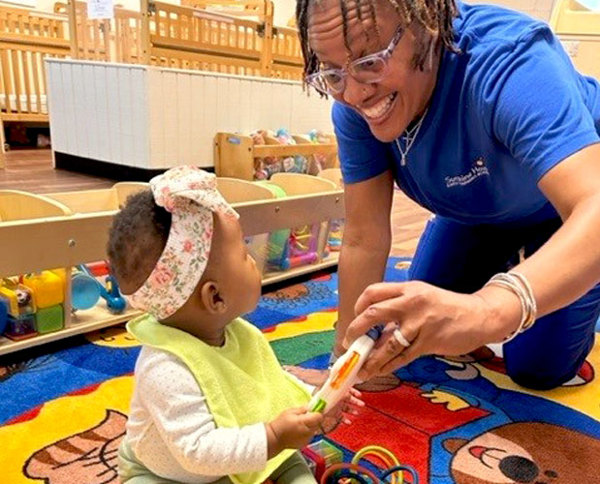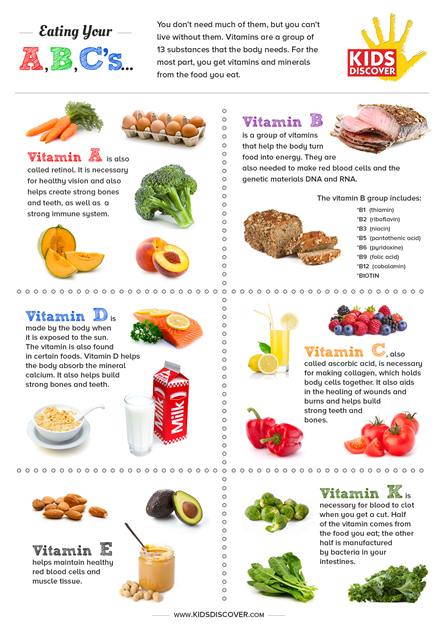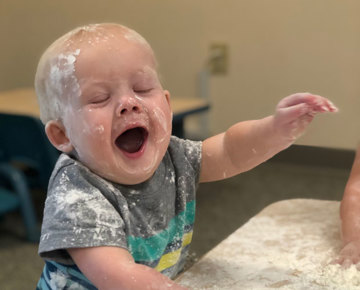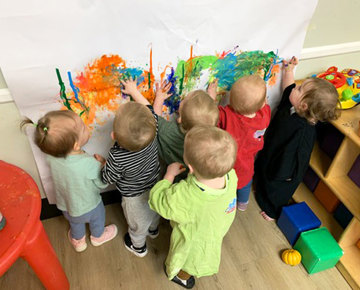Investing in Children’s Relation$hip Bank

Investing in Children’s Relation$hip Bank
 by Bianca Dubois, Education Specialist
by Bianca Dubois, Education Specialist
A core value of our company is building and maintaining relationships - with staff, with children, and with families. Relationships are a crucial component of early learning and embedded in our curriculum for all ages. Children who feel safe and cared for are more receptive to engaging in early learning activities with their caregivers.
When children engage in learning activities, they build upon current brain connections and form new ones. This leads to healthy growth and development in our programs.
So, how do we engage children?
Well, first we have to build a bond with them.
Early childhood education is not a “one size fits all” approach - each child interacts and learns in a unique way. When we seek to understand children’s interests and get to know them, we are better prepared to find ways to motivate children to engage in the learning experiences we plan for them.
When you focus on details from your interactions with children you can use those as a bridge between the child and their learning encounters in your classroom. This might sound like a big ask, but you are already a master relationship builder. You know very specific information about the children in your care and how to meet their needs.
For example:
Billy needs a pacifier for nap, Silver loves playing alone with cars in the block area, Jeremiah enjoys cooking in the pretend area with peers, Paris likes to use the magnifying glass when the clean-up song plays to search for toys.
These are all details we learn over time when we interact with children throughout the day. When we integrate the knowledge base of what we already know about individual children, we can then tailor our teaching styles to the individual needs of children.
For example:
If I know Bryson really likes blocks, I might think about him when I’m creating my lesson plan and choosing an enhancement for the Block area. I can also greet Bryson in the morning and talk to him about the new pictures I placed in the block area for inspiration.
If Alaina is drawing a dragon in the art center, I would ask her to describe what she is drawing so I can label her picture with her own words and suggest we make a dragon book for the library.
These examples are ways we use the interactions we have with children, build upon them, and extend their knowledge in new learning experiences.
So, what can you do today to begin or continue building relationships with children to enhance your learning opportunities with them?
Make emotional deposits to fill their relationship bank. When you have frequent, intentional interactions with children throughout the day, you have the opportunity to make an emotional deposit in their relationship bank.
Here are 5 opportunities to make emotional deposits you can begin today:
1. Greeting in the morning:
- Give a high five, fist bump, wiggle your fingers, or gently place your hand on a child’s shoulder and make eye contact when saying “Good morning!”
- Send the message that you are happy to see them today and are excited about what you have planned for them.
2. Acknowledge when a child exhibits effort:
- A building, a drawing, an interaction with a peer - let them know you noticed.
- “I saw you give that extra block to Roy when he asked for it - that was kind!”
- “You used 5 green blocks to build a tall tower - you did it!”
3. Mealtime conversation:
- Talk about food colors, textures, vitamins in the food, how we share meals at home, and how we prepare or serve meals.
- “Which food will you try first? The carrots? Carrots have Vitamin A which helps make your eyes strong! Do you eat carrots at home too? Have you ever picked a carrot? They grow in the ground and make long roots - you have to pull them out of the ground and wash them before you eat them.”

4. Frequent interactions:
- Smile at children when they are playing, move around the room and narrate what the child is doing.
- “Wow, I see the pan in your hand. Are you going to use it to cook something on the stove? Can I add some apples to your pan?”
5. Salutations:
- While checking out with families, give one description of something specific their child did that day.
- “Billy built a tall tower today with 5 green blocks. He’s really showing interest in stacking.”
- “There is a drawing to take home. Serena used different colored crayons today in the art center and she was so proud of her masterpiece!”
Rich interactions with children lead to strong bonds between children and their caregivers - and that is always a perfect fit!

